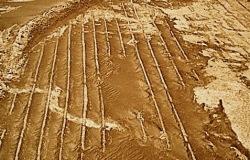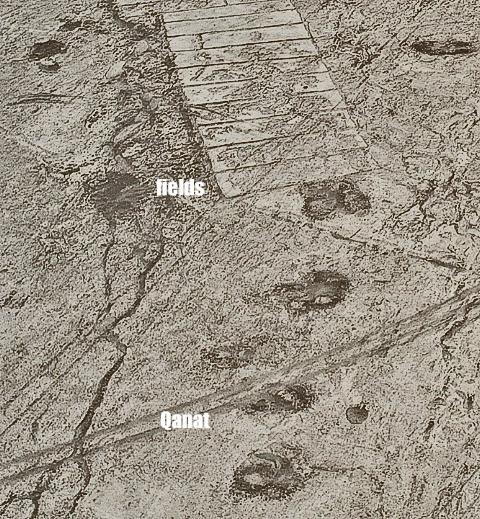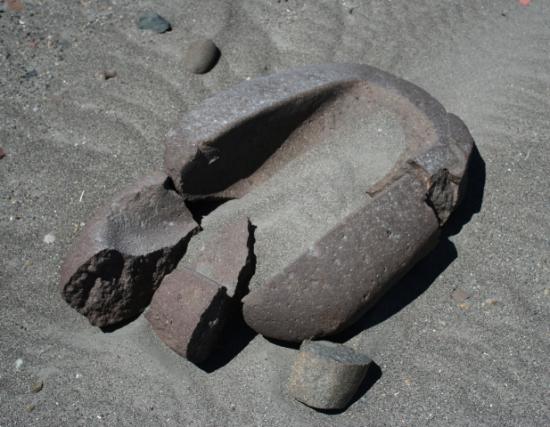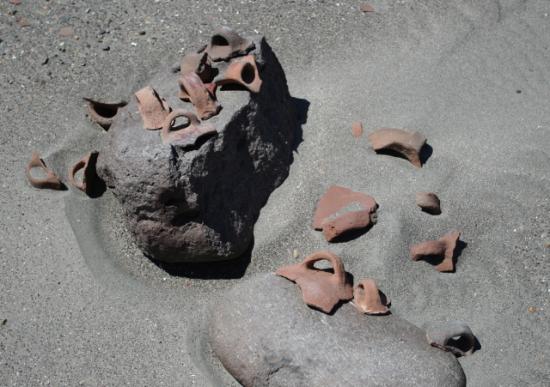Source - http://popular-archaeology.com/issue/march-2013/article/real-or-desert-mirage

It is considered the driest desert in the world. Without provision, a person would not last long in this hostile place, where after a few days without water one just might hallucinate, might see things that simply were not there. And it could be that a small group of people may be seeing things in this place that are not what they seem to be -- lines and walls on a landscape, remains of structures that may or may not be man-made. The site, located in the Atacama desert, a 105,000 square kilometer (41,000 sq mi) plateau along the Pacific coast of Chile, has attracted the focused attention of only a few to date. Most professional news organizations and journals will not touch the story, presumably because there is not enough solid information and evidence about the site advanced by any professionally recognized archaeologists or scholars to justify the risk of publishing even an acknowledgement of its existence.
But many great archaeological discoveries were first stumbled upon by amateurs or non-archaeologists simply exploring the landscape, and some even by individuals who were regarded by some as being on the fringe of their credibility spectrum. Such may or may not also be the case for this site, recently discovered by retired 79-year old Holly Ahlberg using Google Earth from her personal computer out of her home in the Sedona Shadows community in Sedona, Arizona. If the site is legitimate, it isn't the first time such a discovery was made using the popular application: In 2007, for example, Professor Lee Berger of the University of the Witwatersrand in South Africa used Google Earth to locate new cave sites that eventually led to the discovery of 2 million-year-old hominid (ancient human ancestor) fossils that have shaken up the world of human origins research, and Professor David Kennedy of the University of Western Australia used Google Earth to scan the desert landscape of Saudi Arabia for archaeological sites, identifying thousands of tombs and other sites, some of which may be as much as 9,000 years old. Like Kennedy's revelation, Ahlberg hopes that her find will develop into a major archaeological discovery.
Her observations would have meant nothing more than strange, inexplicable markings in the Atacama Desert if she had decided to dismiss them and move on to other things. But she had friends who could help clarify the picture, even if only slightly. She contacted author and researcher Lloyd Pye, who assembled a small team to investigate, including an explorer, Brien Foerster, and a drone pilot, Jeff Taylor of Event38 Unmanned Systems. None of them were trained archaeologists, and some might even consider them "outside the mainstream", but they were willing to commit the time and resources to investigate the location of the markings on the ground.
It was a start.
Utilizing a remote-controlled aerial drone equipped with a camera, the team was able to acquire more detailed aerial photos of the site, which they estimate to be very large: about 11 miles in length and 6 miles in width (as large, Ahlberg maintains, as Manhattan). They photographed what they suggest appear to be the remains of roads, salt pans, walls, possible house structures, the possible foundations of a large circular structure of monumental proportions, and possible ancient qanats (underground canals for irrigation and other purposes). Many of the features detectable from Google Earth and drone aerial views were undetectable from the surface, according to the investigators.
But some of them, including small finds, could be easily seen and handled from the surface, they claim. Purportedly found during the site surface exploration forays were fragments of pottery, including a pot that contained what they interpret to be a possible child skeleton, and remains of a metate, a tool used to grind grain in food preparation. (See images below). Clearly, according to them, there was a human presence here.

The circular feature

Drone aerial view of "fields" and "qanats"

Surface find: the "metate"

Surface find: pottery shard

Surface finds: assemblage of diagnostic pottery shards
Real or hoax?
To be sure, many questions remain to be answered, not the least of which revolves around the validity or existence of the site itself as corroborated by any future archaeological investigation. Ahlberg is calling on the professionals to determine if the "proof is in the pudding".